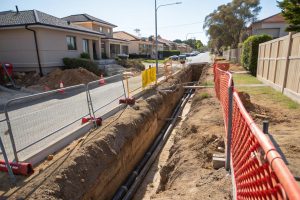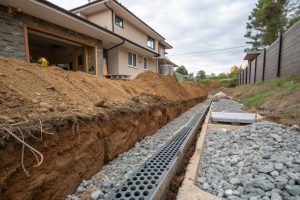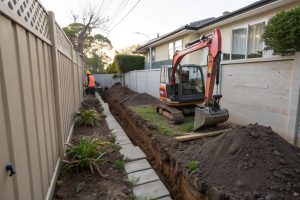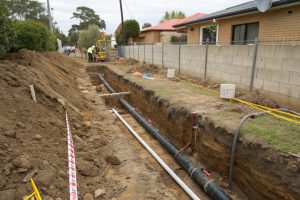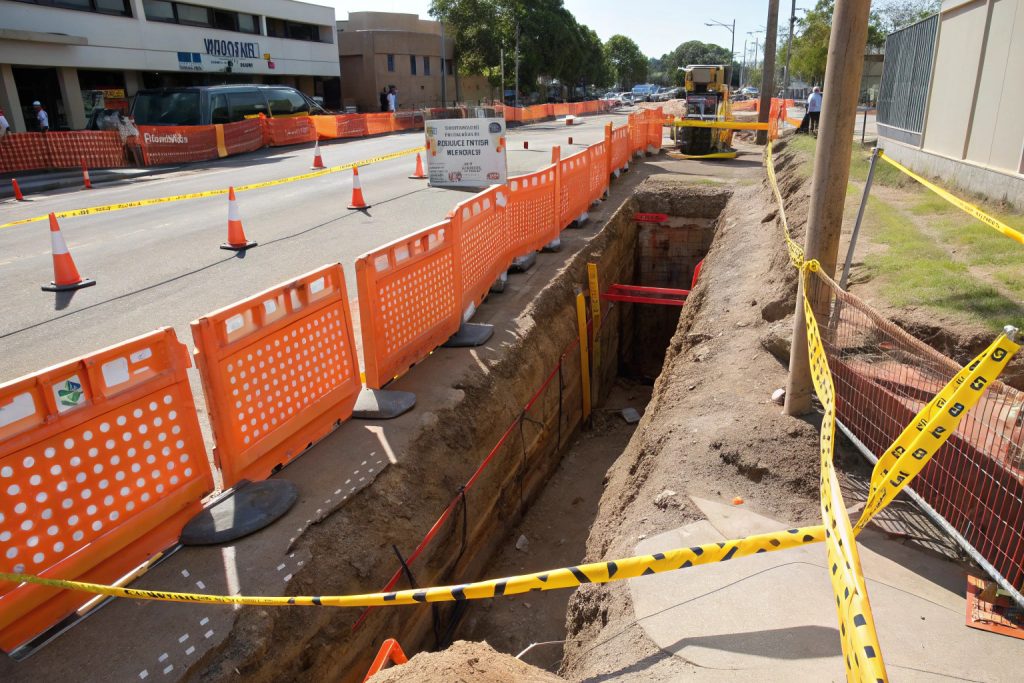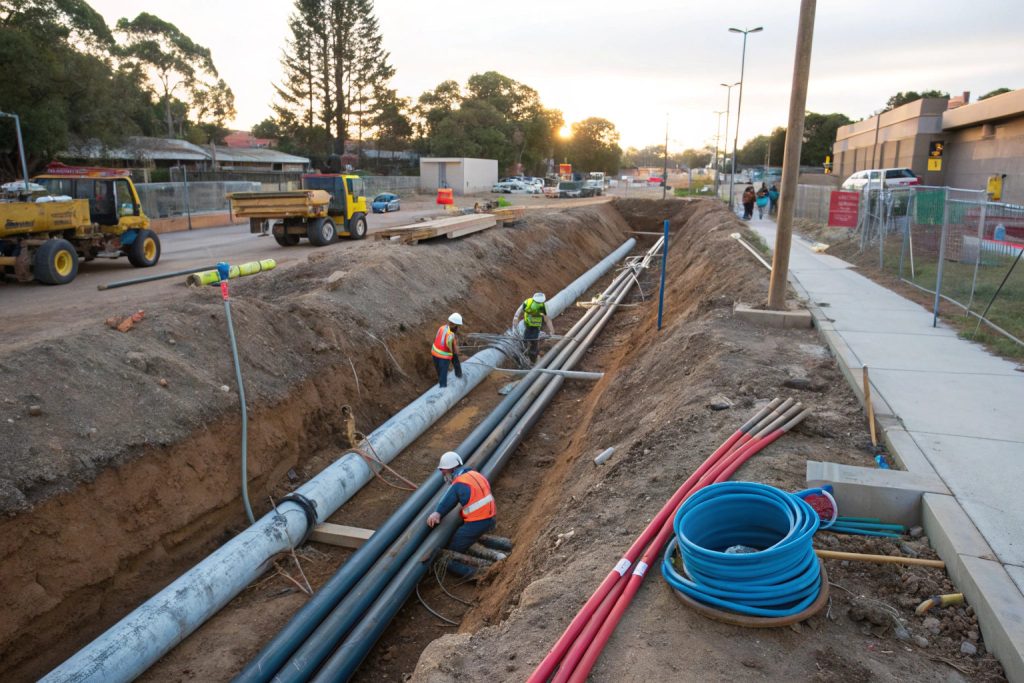Professional Trenching Services in Canberra ACT

Trenching services in Canberra handle the underground work your property needs – from utility connections and drainage systems to electrical conduit and water line installations across the ACT.
Modern trenching combines precision equipment with thorough planning. Narrow excavations reach the exact depth required, expose what needs accessing, and get backfilled quickly. The process protects existing services, minimises property disruption, and meets local safety standards.
Whether you’re connecting utilities for a new extension, installing drainage around your commercial property, or laying cable for outdoor systems, the right trenching approach makes the difference between smooth completion and costly complications.
Utility Upgrade Needs
Properties across Canberra frequently require utility trenching for renovations, extensions, and infrastructure improvements. New water service connections bring mains supply to additions. Electrical upgrades power outdoor areas and secondary dwellings. NBN installations require cable trenching to connection points. Drainage improvements prevent water damage around foundations.
What Trenching Services Include
Utility and Infrastructure Trenching
- Water and sewer line installation and connections
- Electrical cable and telecommunications trenching
- Gas pipeline trenching for utility hookups
- NBN and fibre optic cable installation
- Underground power service connections
Drainage and Stormwater Systems
- Residential drainage system installation
- Commercial stormwater management trenching
- French drain and agricultural drainage work
- Retaining wall footings and foundation trenches
- Irrigation system trenching for landscaping
Understanding Trenching Costs
Trenching costs vary based on depth, length, soil conditions, and site access. Shallow trenches for irrigation cost less than deep excavations for sewer connections. Rock and hard clay increase expenses compared to standard soil. Tight spaces requiring hand digging or compact equipment add labour time. Restoration needs affect final pricing – basic backfilling costs less than reinstalling pavers or returfing established lawns.
- Depth and trench length directly impact per-meter rates
- Soil conditions, including rock, clay, and underground obstacles
- Site access limitations and equipment requirements
- Restoration specifications and surface matching needs
Trenching Methods for Different Projects
The trenching method depends on your project requirements, soil conditions, and what’s already underground.
Hand Trenching
Manual excavation works best for tight spaces, sensitive areas, or locations where machinery can’t access. Hand trenching provides maximum control around existing services and in established gardens. The process takes longer but prevents damage to the surrounding infrastructure.
Mechanical Trenching
Excavators handle longer runs and deeper trenches efficiently. Compact machinery works in residential areas with limited access. Standard excavators tackle commercial projects and large-scale installations. Mechanical trenching completes projects faster while maintaining precision.
Hydro Excavation
High-pressure water and vacuum systems expose utilities without damaging them. This method works perfectly around existing services where traditional digging creates risk. Hydro excavation costs more but prevents expensive repairs from accidentally cutting through pipes or cables.
Rock Trenching
Canberra’s geology includes areas with rock and extremely hard clay. Rock trenching requires specialised equipment – rock saws, breakers, or drilling. The extra equipment and time increase costs but provide the only practical solution in these conditions.
Safety and Compliance Requirements
Trenching work in the ACT follows strict safety protocols to protect property and existing infrastructure. Every project starts with Dial Before You Dig utility location services, identifying underground water, sewer, gas, electrical, and telecommunications lines. Trenches deeper than 1.5 meters require shoring or battering to prevent collapse. Council permits apply for work in nature strips, footpaths, or road reserves. Sediment control and erosion barriers protect surrounding areas during excavation.
- Dial Before You Dig utility locate utilities before any excavation
- Trench shoring and cave-in prevention for deep excavations
- ACT council permits for public land trenching work
- Environmental protection and sediment control measures
Professional Coordination with Other Trades
Trenching projects often require coordination between multiple contractors. Plumbers install water and sewer lines after trenches reach the proper depth. Electricians run conduit for underground power before backfilling begins. Landscapers restore surfaces once utilities are connected. Professional trenching contractors schedule work around these trades, ensuring each specialist completes their portion efficiently. Proper coordination prevents delays, reduces costs, and delivers finished projects without complications or rework.
Get Your Trenching Project Started
Trenching services in Canberra require precision, safety awareness, and proper planning. Whether you need utility connections, drainage installation, or infrastructure work, professional excavation protects your property and existing services.
Contact us for a detailed assessment of your trenching requirements. We’ll evaluate site conditions, identify potential complications, and provide transparent pricing for your project across the ACT.
Frequently Asked Questions
Water and sewer lines typically require trenches 600mm to 1.2 meters deep. Electrical conduit needs a minimum of 450mm depth for residential installations. Drainage pipes vary from 300mm to 900mm, depending on the system. Gas lines follow specific depth requirements based on pressure ratings. Local codes and utility provider specifications determine exact depths.
Private property trenching generally doesn’t require permits unless you’re working near easements or connecting to mains services. Work in nature strips, footpaths, driveways crossing council land, or road reserves requires council permits. Commercial projects may need additional approvals and traffic management plans.
Professional trenching minimises damage through careful planning and execution. Excavators use narrow buckets creating trenches just wide enough for the installation. Topsoil gets separated and replaced during backfilling. Turf can be cut and relaid, though some settling occurs initially. Most lawns recover fully within several months.
Dial Before You Dig plans show registered utilities, but unmarked services occasionally exist. Professional contractors use detection equipment and careful excavation techniques around known utility corridors. If an unmarked line gets damaged, work stops immediately, the utility provider gets contacted, and repairs happen before continuing.
Trenching continues year-round in Canberra with proper precautions. Wet soil requires dewatering pumps and additional erosion control. Frozen ground in winter makes excavation difficult and may require scheduling delays. Summer provides optimal conditions, though hard clay can challenge equipment. Professional contractors adapt methods to seasonal conditions.
Services
Our Global Worldwide Partners
– Concrete Bundaberg
